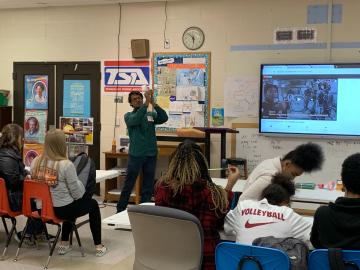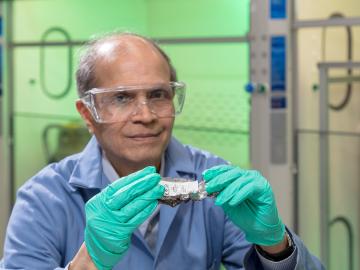
Filter News
Area of Research
- (-) Clean Energy (69)
- (-) Fusion Energy (5)
- (-) Materials (50)
- Advanced Manufacturing (4)
- Biology and Environment (17)
- Climate and Environmental Systems (2)
- Computer Science (2)
- Energy Sciences (1)
- Fusion and Fission (5)
- Isotopes (4)
- Materials for Computing (5)
- National Security (12)
- Neutron Science (27)
- Nuclear Science and Technology (22)
- Nuclear Systems Modeling, Simulation and Validation (2)
- Quantum information Science (3)
- Supercomputing (38)
News Topics
- 3-D Printing/Advanced Manufacturing (21)
- Advanced Reactors (7)
- Artificial Intelligence (4)
- Big Data (4)
- Bioenergy (10)
- Biology (1)
- Biomedical (3)
- Biotechnology (1)
- Chemical Sciences (2)
- Clean Water (1)
- Climate Change (7)
- Composites (1)
- Computer Science (17)
- Coronavirus (8)
- Critical Materials (2)
- Cybersecurity (2)
- Decarbonization (1)
- Energy Storage (19)
- Environment (19)
- Exascale Computing (2)
- Frontier (1)
- Fusion (4)
- Grid (6)
- High-Performance Computing (1)
- Isotopes (1)
- Machine Learning (6)
- Materials (2)
- Materials Science (33)
- Mathematics (2)
- Microscopy (6)
- Molten Salt (1)
- Nanotechnology (13)
- National Security (1)
- Neutron Science (13)
- Nuclear Energy (8)
- Physics (8)
- Polymers (6)
- Quantum Science (5)
- Security (1)
- Summit (5)
- Sustainable Energy (22)
- Transformational Challenge Reactor (4)
- Transportation (13)
Media Contacts

In the Physics Division of the Department of Energy’s Oak Ridge National Laboratory, James (“Mitch”) Allmond conducts experiments and uses theoretical models to advance our understanding of the structure of atomic nuclei, which are made of various combinations of protons and neutrons (nucleons).

In the race to identify solutions to the COVID-19 pandemic, researchers at the Department of Energy’s Oak Ridge National Laboratory are joining the fight by applying expertise in computational science, advanced manufacturing, data science and neutron science.

Sometimes conducting big science means discovering a species not much larger than a grain of sand.

Scientists at Oak Ridge National Laboratory used a focused beam of electrons to stitch platinum-silicon molecules into graphene, marking the first deliberate insertion of artificial molecules into a graphene host matrix.

Ilias Belharouak is leading ORNL’s research efforts in investigating new materials for solid-state batteries, which can double the charging capacity of lithium-ion batteries, commonly used today for electronic devices such as cell phones.

Mircea Podar, Distinguished Staff Scientist and Leader of the Systems Genetics Group in the Biosciences Division at Oak Ridge National Laboratory, has been elected fellow of the American Academy of Microbiology.

Jitendra Kumar, a researcher at the Department of Energy’s Oak Ridge National Laboratory, has been elevated to the grade of senior member of the Institute of Electrical and Electronics Engineers (IEEE).

Hydropower developers must consider many factors when it comes time to license a new project or renew an existing one: How can environmental impacts be mitigated, including to fish populations?

“Engineering is about building things to help others.” Before diving into a longer explanation, that’s how Singanallur “Venkat” Venkatakrishnan, an electrical and computer engineer ORNL, described engineering to students at Northwest Middle School.

Three technologies and one commercialization program developed at the Department of Energy’s Oak Ridge National Laboratory have won National Technology Transfer Awards from the Federal Laboratory Consortium.


